
BREEAM
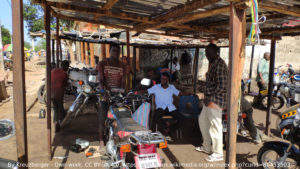
Welcome to BREEAM: The Energy Efficiency Podcast – episode 12, the podcast that brings you a mix of energy efficiency news, products and tips all year round. We’re interested in profiling people and products involved in promoting energy efficiency habits, products and information, so please do get in touch if you have something to contribute.
This week: BREEAM – we often mention it, but what is it? The health benefits of energy efficiency, and mending household items – it’s new and cool but some of us have been doing it for years.
Circular economy
But before we get on with our advertised features, last week the Guardian reported on a business complex in Rotterdam housing 30 businesses. Nothing new in that you might think, but BlueCity brings all the businesses together to trial a circular economy. The principle of the circular economy is that nothing is wasted, ie that materials remain in use for as long as possible and use of new raw materials is minimised.
The Netherlands has in place a government-wide programme aimed at developing a circular economy in the Netherlands by 2050. If you so wish there’s a 72 page PDF on this, in English, that you can download from the Dutch government website – link in the show notes. The plan is to halve raw material use by 2030, and Rotterdam wants to be in the vanguard of this. Rotterdam is a port city which has led to it becoming an emissions hotspot and consumer of significant quantities of raw materials.
SMEs

Interestingly, the Dutch government has identified SMEs as crucial to the success of the circular strategy programme. They make a big contribution to Rotterdam’s economy and so can lead in changing business habits. Rotterdam is conducting a four year pilot project, in which sites such as BlueCity will be central. The building is a disused Center Parcs venue named Tropicana. Businesses moving in represented a shift from circular economy planning to doing.
Renovation of the building isn’t complete but new parts are opening. In the basement worms compost all organic waste. Reuse of a derelict building sets BlueCity apart from other projects globally, although the Dutch do seem to have a flair for reusing old sites. BlueCity’s unique setting, in a redeveloped holiday centre, has attracted the sort of attention that means it can be 90% self-funded. However some involved fear that Blue City will become more of a tourist attraction than a catalyst for wider change. To counteract this Blue City is connecting entrepreneurs with corporates who want help with waste solutions. It runs events, including debates, to deliver practical advice.
The concerns about becoming a tourist attraction instead of a game changer are understandable, but at this stage we still seem to need colourful projects to bring home what can be achieved. Only when sustainability behaviour excites no attention whatsoever but is part of the furniture will we really have succeeded.
BREEAM
We’ve mentioned BREEAM a few times now in the context of buildings that have achieved high BREEAM ratings. Nothing to do with fish, BREEAM stands for Building Research Establishment Environmental Assessment Method. It’s a scientifically-based method developed by the Buildings Research Council (BRE) that assesses, rates and certifies the sustainability of buildings. It began in 1990 and in the last almost 30 years over half a million certificates have been issued in 83 countries.
BREEAM categories evaluate energy and water use, health and wellbeing, pollution, transport, materials, waste, ecology and management processes. A building can be rated Acceptable (In-use scheme only), Pass, Good, Very Good, Excellent and Outstanding. Crucially a good BREEAM rating provides market recognition of a building’s sustainability.
Expansion
BREEAM started out assessing new office buildings. This expanded to include large supermarkets, industrial units and existing offices. In 1998 BREEAM was shaken up and a weighting for different sustainability considerations introduced. From that point onwards annual updates were issued to the standard and more types of building included. Over the last 30 years BREEAM’s focus has increased. It started out applying just to individual new buildings. Now it covers the lifecycle of a building from planning through use to refurbishment.
In 2000 a version of BREEAM called Eco Homes was introduced covering new builds. This was the basis for the Code of Sustainable Homes developed by the BRE for government in 2006/7. That has been withdrawn by the government since 2014 so BREEAM has introduced the Home Quality Mark. In 2011 BREEAM New Construction was launched and is now used to assess and certify all new UK buildings.
Widely applicable
We’ve heard in previous epsiodes about the value of monitoring energy efficiency methods and energy ratings. In 2008 BREEAM included mandatory post-construction reviews, as well as international versions of BREEAM. The regular updates are a response to the need for improved sustainability, and UK government policy on sustainability. They ensure BREEAM remains flexible and widely applicable.
This wide application includes worldwide BREEAM certification. In several European countries partner organisations carry out BREEAM assessments. These include The German Institute for Sustainable Real Estate and the Instituto Tecnologico de Galicia in Spain. International assessment allows BREEAM certification to relate to local context and existing schemes.
Highly rated
BREEAM itself comes extremely highly rated. A survey of companies that had used BREEAM found that 88% think it’s a good thing, the same number would recommend BREEAM, and 96% would use it again. These enviable figures challenge the perception that designing in sustainability increases the cost and complexity of a project. As we’ve looked at in previous episodes, sustainable buildings are usually pleasant to be in, whether that’s to live, work, study, undergo treatment or buy your groceries. Enhanced sustainability can increase a building’s market value. Research from Maastricht University published by the Royal Institute of Chartered Surveyors found that BREEAM-certified office buildings in London attract a 21% premium on transactions and 18% premium on rents.
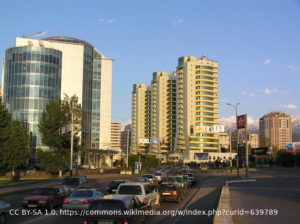
Recently the first office building in central Asia gained a BREEAM In-Use certificate. Park View Office Tower in Almaty, Kazakhstan, achieved a Very Good for Building Management under the In-Use International class. The building’s owners, prominent central Asian real estate company Global Development, described the BREEAM process as a great experience. They view the certification as confirming the building’s top class status. Office space in the building is highly sought after and the building recently won another award for best office building at a real estate event. It’s very encouraging to see big property players valuing sustainability certification. The assessment was carried out by Drees and Sommer, a German company carrying out project management, engineering and consulting across Russia and the CIS (countries formerly part of the Soviet Union).
Schools using BREEAM
In Milwaukee, Wisconsin, a high school in a 60 year old building applied the BREEAM In-Use programme to identify which parts of operations met sustainability goals, and which needed improvement. Homestead High School has seen refurbishment and extension since 1959 and now educates 1400+ students to a nationally recognised standard of excellence. Homestead sports an indoor swimming pool, a performing arts centre, over 100 classrooms, ventilated labs and more. It has 34 air handles and two 300-ton chillers. Looking for BREEAM rating has come about as part of Homestead’s desire to clearly demonstrate the results of the investment it’s had.
Homestead’s consultant, Richard Walker, describes the process as affordable and praises BREEAM’s online learning tools that it used to help educate students about the sustainability programme. Homestead is now turning this into part of the curriculum with a view to creating valuable skills for the future. These features gave BREEAM an advantage over other rating systems.
As we’ve seen, a sustainable environment has huge benefits for those who spend time in it. At Homestead High School pupils are in a facility that Kyle Thompson, its Director of Facilities, describes as “conducive to learning”. He goes on to say:
“Homestead was no stranger to energy efficiency. It was already working with Trane Energy Performance which reviewed Homestead’s equipment to recoup $55,000 a year, 10% of its energy bills. It was Trane that recommended BREEAM. Since implmenting the BREEAM In-Use programme Homestead High School has seen improved student attainment, reduced truancy, happier staff and vitally better staff retention. Overall wellbeing is improved.”
Impartial
One of BREEAM’s strengths is that assessments are carried out by licensed but impartial third parties. What does an assessor look for in the energy category? This section looks for comprehensive energy efficiency across building design and spec, systems and equipment. These elements must support the sustainable use and management of energy in the building and its operation and encourage the reduction of carbon emissions.
In each category aims, targets and benchmarks are set. When the assessor deems one of these to be reached the project acquires credits. The category is then ranked according to these credits and the category’s weighting. These taken together across all categories lead to the final performance rating.
If you’re looking to achieve a BREEAM rating for a building or project, first decide which standard applies to it. Next you appoint a licensed BREEAM assessor and register your project for assessment. Together with the assessor a pre-assessment is carried out. Keep the assessor informed with all necessary paperwork etc as your project progresses. The assessor reviews this against the standard then submits this assessment to the certification body and the appropriate level of certification is issued.
Concerns
There are however concerns that BREEAM standards could test for sustainability more widely. 2019 research from Sheffield Hallam University concludes that BREEAM should focus more on three points:
- product lifetime economics
- the geographical location and environmental properties of the site
- post construction, continual monitoring of effectiveness and evaluation of impacts
It also suggests that there is too much weight given to an assessor’s definition of “sustainable development”. We’ll link to the PDF report so that if you want to you can read the research and make up your own mind. It is important to be wary of tick box exercises and greenwashing, but at the same time just because something isn’t perfect doesn’t mean it’s no good or not worth bothering with. Working to BREEAM standards has clearly had a hugely beneficial effect on thousands of projects. Undoubtedly there is work still to be done, learnings to be had, and BREEAM recognises this with its frequent revisions and updates. A great deal has been achieved in 30 years and what was once a bit niche is becoming increasingly widely sought after.
Mending household items
 My colleague Kevin’s been joining in on the podcast recently. Ecoflap is a family business, so as well as being colleagues we’re married. In our house whenever anything is broken there’s an assumption that Kevin can fix it, with his engineering background.
My colleague Kevin’s been joining in on the podcast recently. Ecoflap is a family business, so as well as being colleagues we’re married. In our house whenever anything is broken there’s an assumption that Kevin can fix it, with his engineering background.
Sometimes that’s easier than others, and that’s the point of new EU legislation that comes into force in April 2021, which unfortunately looks likely to be a bit late for us. The new legislation obliges manufacturers to make appliances more easily repairable and long-lasting. This should be a massive win for consumers.
The UK will have to abide by EU rules if it wants to export to the EU. What do the rules apply to?
Initially it will cover everyday products such as lighting, big screens and white goods, so fridges, washing machines and dishwashers. The European Environmental Bureau (EEB) would like to see it include smartphones and printers. As I recall you’ve fixed all of those for us?
Yes, new control panel on the dishwasher, several sets of brushes on the washing machine (plus numerous dismantlings of the filter to remove lego and hair clips) and at least two new thermostats on the fridge plus repairing the door hinge.
Yes, the fridge door fell off onto Kevin but tragically we lost a bottle of wine. The point is that none of these appliances are designed to be at all friendly to home mending. Recently I killed an electric mixer by getting dough into its workings. In order to fix it Kevin had to buy a special tool that undoes a screw the manufacturer fits simply to prevent you getting in to the machine.
They talk about electrical safety.
Do you think that’s as much of a danger as the manufacturers like to say?
Not with independent repair professionals. DIYers could do themselves a mischief if they don’t know what they’re doing. but worse can happen trying to get around tamper proof fixings.
Of course, and that’s a real consideration, but let’s be honest, the manufacturers want you to go back to them and buy another £20 hand mixer.
Or £500 smartphone.
In this case, the mixer was fine but just needed the now set rock hard dough removed from its nether regions. It wasn’t broken and I didn’t need a new one, it just needed some attention.
This is a small example but a 30 second search on the internet will bring up thousands of cases of consumers told they need an entirely new fridge/freezer/washing machine because one small and easily replaceable part has worn out. Environmentally this is a disaster. And those lamps with sealed-in bulbs that you can’t replace should be illegal. The waste is horrifying and items like this normalise it. In some cases there’s a suggestion that products are designed to fail soon after their warranty expires. Consumers have had enough of this and in two years time they’ll have legal back-up.
So will it be easy to get my hands on the information I need to repair things?
The victory isn’t complete. The legislation will require only that spare parts and manuals are made available to repair professionals.
No good for repair cafes, then?
No, this is a missed opportunity. Repair cafes have become very popular in the last few years. Usually running on a pop-up basis, repair cafes offer expert help to mend bikes, small electrical items, computers, garden tools, ceramics and so on. Our big old ceramic fruit dish was beautifully repaired through one of these and carries on doing its job to this day. You’ve taken part, haven’t you?
Yes, with my electrical engineering head on. I helped to sort out a few laptops.
But it’s not just volunteer repair cafes that may struggle to get their hands on the parts and information they need. Independent repair companies thrive in many places and they too may suffer. There’s a suggestion that the EU buckled under pressure from industry lobby groups and reduced the right to repair in favour of increased recyclability. That’s not a lot of help to the consumer. Surveys have shown that a majority of EU citizens would like information about repairability when they buy a product, and then to be able to fix it if it does go wrong.
You use online tools to help sometimes, don’t you?
Yes, YouTube is great for that. Be careful or mindful of the YouTuber or HowTo author’s skillset and of your own skills and limits. If you are not sure of what you can do and perhaps more importantly what you can’t – don’t. Things such as messing with gas supplies and appliances and electrical systems, save that for a professional.
E-waste
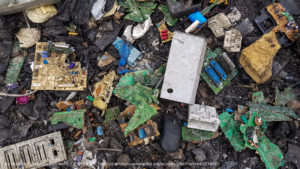
Repairability is far more environmentally friendly than recycling. Remember the mantra refuse, reuse, recycle. Ie don’t take, buy or use an item in the first place, reuse what you have and finally recycle what you can’t reuse.
Electronic waste is the fastest growing waste stream worldwide and can contain some hard or impossible to recycle materials. This year we’ll reach a mind-blowing 50 million metric tons of electronic waste – the weight of eight pyramids for god’s sake. Only 35% of electronic waste in the EU is collected and disposed of properly. In 2016 the total value of raw materials present in electronic waste – that’s waste – was E55billion. The UN has warned that this type of waste is a major threat to human health. Set against that, allowing someone to replace their own iPhone screen doesn’t seem a huge threat to Apple’s profits. There’s a detailed explanation of how the proposals have been watered down on the CoolProducts website.
What are we doing to make our products repairable? We’ve designed in a lot of that this year, haven’t we?
Yes. mainly for post manufacture repairs of products where something needs replacing because of damage discovered during the process of building or packing or even material failure – like packaging failing! But also making it possible to repair further into the life of the product as we want to make products that last. It’s not just about the bottom line for our business but optimising the resources used not maximizing profit.
Some products are intrinsically almost impossible for the consumer to repair. Computerised systems and internal complexity have a lot to do with this, but Nabil Nasir of the Rochester Institute of Technology in the USA says that what was the exception is now becoming the norm. An Economist article describes John Deere tractors as coming with “millions of lines of software code, controlling everything from the engine to the armrests”. In this case John Deere explicitly retains ownership of its software. Manufacturers defend this by saying that restricting repairs protects their intellectual property and consumers’ security. Apple says that if only it can replace the home button, hackers won’t be able to familiarise themselves with how to get round security. This hasn’t been the case with open source software, but that’s a subject for another day.
In America the ‘right to repair’ movement has succeeded in getting relevant legislation on the agenda. The Repair Association, a lobby group funded by repair shops and environmental organisations and other charities, wants American states to pass “right to repair” laws. Their hope is that if one state passes the law, others will follow.
Wasn’t that the case with a car repair law?
I’ve just remembered you’ve fixed our cars too! In 2012 Massachusetts passed a right-to-repair law for cars. This gave repair shops and consumers access to spare parts and diagnostic repair information. One bill was passed in one state, and two years later it was the law throughout the United States.
The Repair Assocation though has a fight on its hands, but when the big companies play tough it tends to bolster the opposition. In France planned obsolescence is illegal and punishable by fines. You have to hope that what is at the moment a fight, viewed as a threat by the corporates and needing to be strong-armed into law one day becomes a no-brainer. The American website ifixit.com has a great page on all this so please do follow the link if you’d like to read more.
The health benefits of energy efficiency
Energy efficiency in the home should mean less fuel is wasted, bills come down and your home is a comfortable temperature all year round. The health benefits of this really don’t need to be spelt out, but if you look at the health consequences of a cold, damp and draughty home, the contrast is stark.
Even as a fairly young, healthy person, feeling cold in your home is unpleasant. As an older person or someone infirm, and/or facing fuel poverty, it’s miserable. Quite aside from contributing to respiratory and circulatory problems, existing health issues are exacerbated and mental health can suffer. Fuel poverty can present a household with the option of heating or eating. This is unforgivable in the fifth richest country in the world.

Working together
Last week we profiled an initiative in Barnsley, South Yorkshire, where health professionals, the social housing sector and energy companies worked together. This ensures that those most in need of a warm home, often following hospital treatment, access a favourable energy tariff, home improvements and advice on managing their bills.
Yorkshire really seems to be leading the way. In Wakefield and Harrogate the Wakefield Housing Health and Social Care Partnership (HHSCP) is underway, again focussing on hospital discharge. This works widely with agencies including the council, fire and rescue and the local NHS clinical commissioning Group. It’s part of the long term plan for the NHS, which makes a lot of sense. Those most in need can find themselves yo-yoing back and forth between home and hospital as poor housing continually makes them unwell. Sort out the housing and preventable admissions should drop. The NHS England website says:
“Poor housing and the impact on health is one area we have pledged to tackle together; it costs the NHS £1.4bn a year but by reducing excess cold to an acceptable level alone we could save £848m nationally and, more importantly, improve people’s lives.”
Councillor Denise Jeffery of Wakefield Council says:
“We have other home energy efficiency and home improvement schemes to help residents save energy, be warmer and healthier in their homes. Through these initiatives we have installed over 10,500 heating and insulation measures, benefitting over 8,000 households since 2006,”
Wakefield & District Housing Ltd, or WDH, is one of the country’s biggest social housing providers. Its housing officers are often households’ first contact with services, making the officers well-placed to identify households that need help.
Research
England has a relatively large number of cold-related illnesses and deaths compared to Europe and considering we don’t usually suffer very cold winters. However cold-related deaths have been falling since the mid-1970s. A study by the NHS National Institute for Health Research concludes that quality of housing in terms of insulation and other energy efficiency measures are likely a factor. The sort of service in place in Yorkshire can be applied widely to bring these numbers down, but more detailed research is needed. Housing stock needs to improve to maximise the health benefits of energy efficiency.
The study evaluated the impact of home improvements over an eight year period, albeit ending in 2010 which is nearly a decade ago. Broadly, vulnerability to cold was better since the introduction of the Winter Fuel Payment, but worse again in years when fuel prices rose. The study suggests that rather than energy efficiency measures increasing the temperature of a house – which they did on average by a negligible 0.1 degree – it’s likely that fitting insulation improved indoor air quality to the point that it made a positive difference. This temperature difference reduces preventable deaths by about 300.
Interestingly the study showed that energy efficiency measures are effective in improving temperatures only up to a point. To quote the research:
“The small gains in winter temperatures arise because most of the energy efficiency interventions have been relatively modest and the shape of the empirical relationship between energy efficiency and indoor temperature shows a relatively
shallow increase in temperatures, with improved energy efficiency and a plateau effect at around 500 watts/K
E-value, a value close to the average energy efficiency of the English stock. Further improvement of energy
efficiency beyond this point appears to result in little or no change in average winter indoor temperatures and
hence in little or no reduction in cold-related deaths from direct exposure to cold.”
Improving indoor air quality is what really makes the difference, specifically ventilation. Ventilation is air movement sought and controlled. Draughts are currents of air unwelcome and uncontrolled. The study also looked at the small risk of insulated warmer-than-average homes causing problems in hot weather, and at the likelihood of smart ventilation measures not being operated effectively.
Long term view
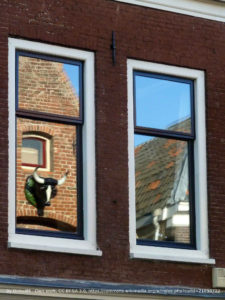
The study’s modelling revealed that the health benefits of energy efficiency become apparent in the medium- and long-term in a way that isn’t seen in the short-term. Spending a similar amount on energy efficiency instead of winter fuel payments reduces CO2 emissions, improves housing stock and leads to health benefits. The study recommends this approach which doesn’t incentivise additional fuel consumption.
Depending on which considerations are given highest weighting, double glazing and boiler replacement come out as the top options. As we saw last week some energy companies are offering boiler replacements as part of their ECO commitments. There’s a 138 page PDF detailing this NHS research, so follow the link if you’d like to read more.
Materials
Health can be affected by many aspects of a building, not just its temperature and levels of insulation. In the USA The National Resources Defense Council has been looking at some of the materials used in improving buildings. It describes some of the materials as “contributing to cancer, respitory disease and developmental and reproductive harm.” If accurate, that does sound rather self-defeating. The good news is that a new report offers guidance for builders and policymakers to find alternative materials. The even better news is that some currently used materials are good from a health perspective, for instance fibreglass and cellulose insulation. As we saw last week, sheep’s wool insulation also comes with health benefits.
Also in America, the Energy Plus Health Playbook is a new policy tool covering energy efficiency retrofits to housing. Really it’s a program that ‘prescribes’ home retrofits for better health. The so-called prescribers are an alliance of hospitals, Medicaid providers, housing agencies, insurance companies and third parties. What’s interesting there is that Medicaid is accessed by America’s poorest families, and insurance companies also play a role in health care in the USA that they just don’t here, so a programme of this sort should ease pressure on both Medicaid and health insurance premiums. States including Missouri and Maryland are changing their Medicaid rules so that it can pay for in-home assessments leading to retrofits.
Eligibility
As we looked at last week, eligibility for energy companies’ funding for energy efficiency work is usually based on income and residency status. In Wales, the Nest scheme which is run by the Welsh government, is introducing health-based eligibility criteria. To quote the Energy Saving Trust page on the scheme:
“It will support Welsh residents living with chronic respiratory, circulatory or mental health conditions who also live on a lower income and are at a higher risk of developing an illness as a result of a cold home. The needs of people with disabilities, older people and families with young children have also been specifically addressed to ensure they can benefit from the scheme.”
Clearly the light bulb has pinged on that quality of housing has a direct effect on health. As well as the schemes we’ve talked about today, which are just a small sample of what’s happening, there is an All-Party Parliamentary Group for Healthy Homes and Buildings. This put out a White Paper in October last year. In the introduction, Jim Shannon, DUP MP for Strangford in Northern Ireland, says:
“Our White Paper makes it clear that healthy homes and buildings would contribute to: – Lower costs to the NHS and a healthier population; – Better educational attainment and workplace productivity; – Reduced emissions, lower energy bills and a lower carbon footprint; – Improved health, wellbeing and comfort; – Greater life chances, independent living and care.”
There you have it. It’s already happening at a local level and internationally. George Clarke has begun a campaign for more and better council housing (which we’re right behind). There’s no argument that bad housing is anything other than bad for health so we hope to see more and more action to make poor, chilly and damp housing a thing of the past.
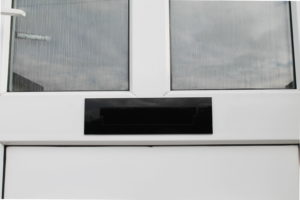
And what have we been up to? We’ve developed the replacement for the Ecoflap, the Letterplate Eco. We expect to have test cuts soon. We’re about to commission test vinyls and trial those. Remember we ship internationally, so if you want a petflap sent outside the UK we recommend you do it soon!
Thank you for listening to episode 12 of the Energy Efficiency Podcast. Until next time you can find us on both Twitter and Instagram as Ecoflap, and on Twitter we also tweet as The Petflap. In next week’s episode we’ll look at LEED green building certification, the environmental reality of Boris bikes and their ilk, and energy efficiency in the music industry.
Music credit: “Werq” Kevin MacLeod (incompetech.com)
Licensed under Creative Commons: By Attribution 3.0 License
http://creativecommons.org/licenses/by/3.0/
